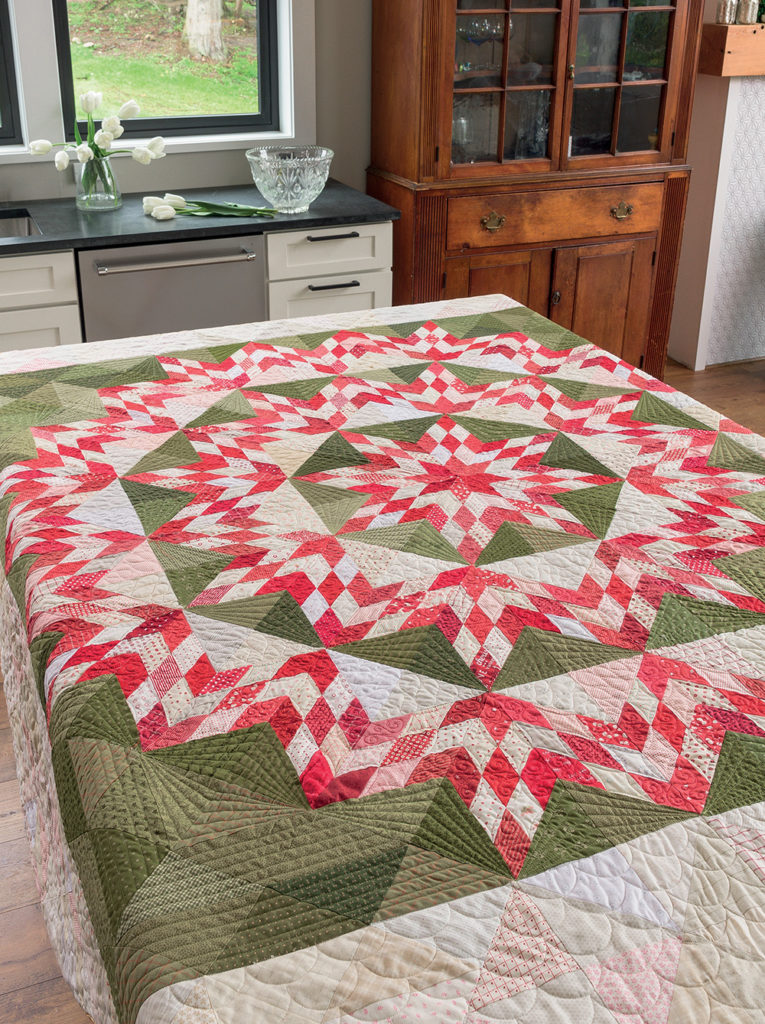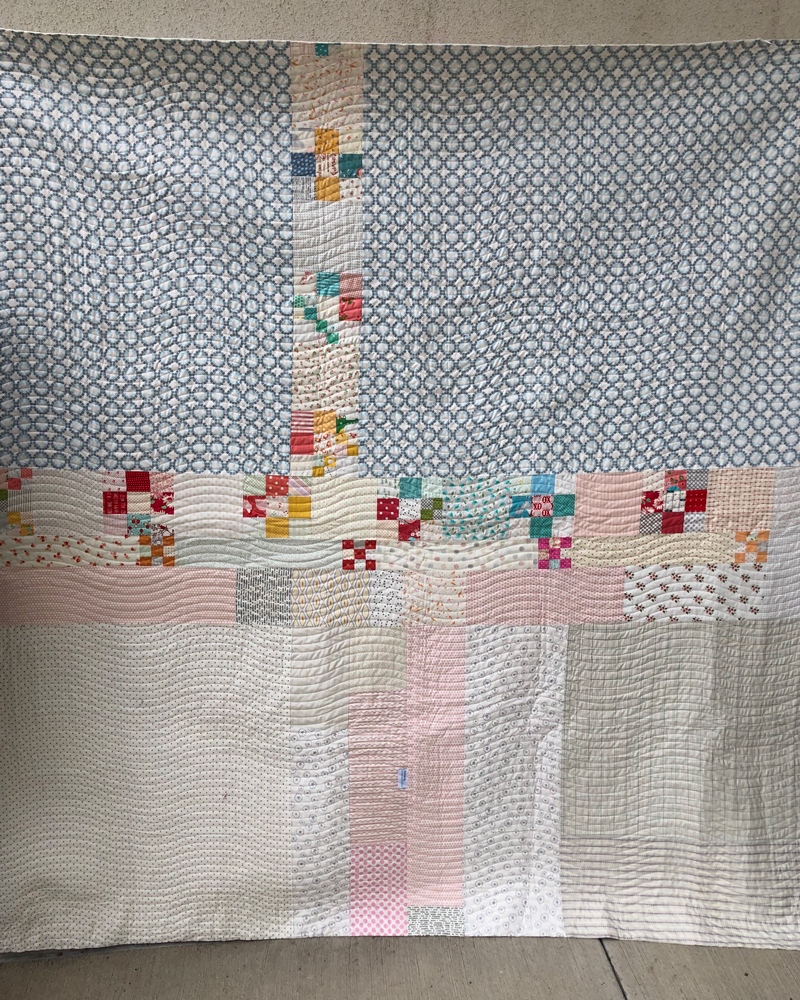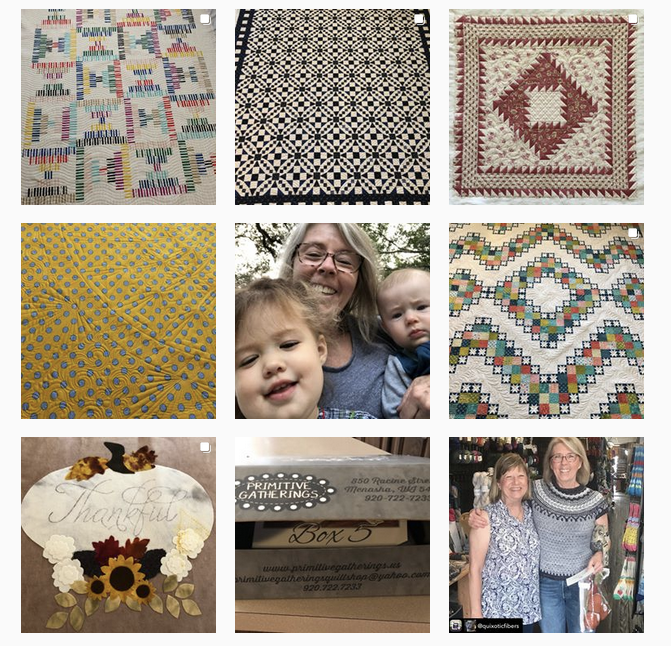Machine quilting is MAGIC, right?
What really is the hardest decision in the quilt making process is how to quilt it. Finding a quilter that can work their magic takes some time. Several of the quilts in Sisterhood of Scraps were quilted by Maggi Honeyman, so I asked her to do a post about how she goes through the process of quilting scrappy quilts.
When Lissa asked me to write a post about quilting scrappy quilts, I knew it was a subject that is right up my alley. My quilt-making journey has been about scrappy quilts from the beginning. The more fabrics that are included in one quilt top, the better! So, when it comes to quilting them, I feel at home. Over the 19+ years that I have been quilting on a long-arm quilting machine for other individuals, there has been a big transformation in how we approach quilting scrappy quilts. When I started, doing an all-over repeated pattern on most quilts just wasn’t the preferred option. This has changed recently, particularly on scrappy quilts.
I am a very traditional piecer and my quilting style definitely tends towards traditional patterns, whether on scrappy or more fabric specific quilts. I always try and let the quilt suggest to me what it needs in the way of quilting when the piecer is unsure of how they want their quilt finished. The types of fabrics or the block design are a couple of ways a quilt can talk to you. Sometimes it takes getting the quilt loaded on the machine; and other times, the quilt speaks for itself. Feathers and crosshatching are always great go-to-patterns for custom quilting. For the more modern quilts, it has been a bigger stretch for me artistically. When deciding on ideas for quilting, I will use a piece of Press-n-Seal to carefully draw on top of the quilt, which helps me visualize how my idea will actually look on the quilt. There is also a multitude of long-arm machine quilters who have written fantastic books with design ideas, as well as internet resources, that have lots of ideas for custom quilting on all types of quilts. These books and the internet have changed the machine quilting world immensely.

Having said this about custom quilting, all-over/edge to edge designs have become much more acceptable, just as machine quilting is more acceptable than it was 20 years ago. When looking at scrappy quilts, I feel that the fabrics and the actual piecing pattern make the biggest or most important statement for a quilt. On these quilts with so much interest in the fabrics and design, the quilting simply needs to add texture and dimension. I will pick an all-over design for scrappy quilts as often as choosing to quilt it custom.

As with scrappy quilts, I have always loved pieced backs. My philosophy is to use what I have and that includes pieced backs. But what I really mean is if I don’t use what I have, then I can hardly justify buying more!! So, when customers bring pieced backs, I am quite ok with that. However, when there are lots of pieces used for the back, it is very easy for the back not to be “square”. Careful measuring and piecing is just as important for the back as it is for the front so that you have a nice flat back. While quilting the top, I can see when a bit of adjustment is needed and I can attend to it. When the back has some less than square properties, it is much more difficult to see and correct while quilting. Many of my quilts have pieced backs, as it adds another artistic element, and making quilts is very much an artistic outlet for most quilters. When I piece my backs, if I am not using some of my leftover blocks for part of the back, I use a ½” seam allowance with a slightly shorter stitch length and then press the seams open.

As far as pressing seams prior to quilting, when a piecer chooses to press the seams open, they should know that any stitch-in-the-ditch quilting is more difficult. Also, stitching in an open seam runs the risk of cutting the piecing threads with the needle while doing the quilting. If the seam is pressed to one side, it gives you the ditch to stitch in, which provides the stability and structure that stitch-in-the-ditch is intended to give. Having said that, open seam allowances allow for much flatter intersections to quilt through and over. Thicker seam allowances always benefit from very good steam/heavy pressing to ensure they are the flattest they can be.
I hope these thoughts have given you some insight into my quilting process for scrappy quilts. Everybody has their own process, but in the end, we are all makers in one big sisterhood of quilters. This is first, a way to relax, express ourselves, belong to a group, and have fun. There are no hard and fast rules and there is no perfection. Make it yours and know I truly love quilting with you!
Thanks so very much for quilting with me,
Maggi
Thank you Maggi for always making my quilts SING! and sharing such great tips.You can find Maggi on Facebook.
and Instagram @sewmaggi
Join me back here tomorrow as I share what Maggi has been working on lately.
** Sisterhood of Scraps is available NOW from your favorite book retailer.
